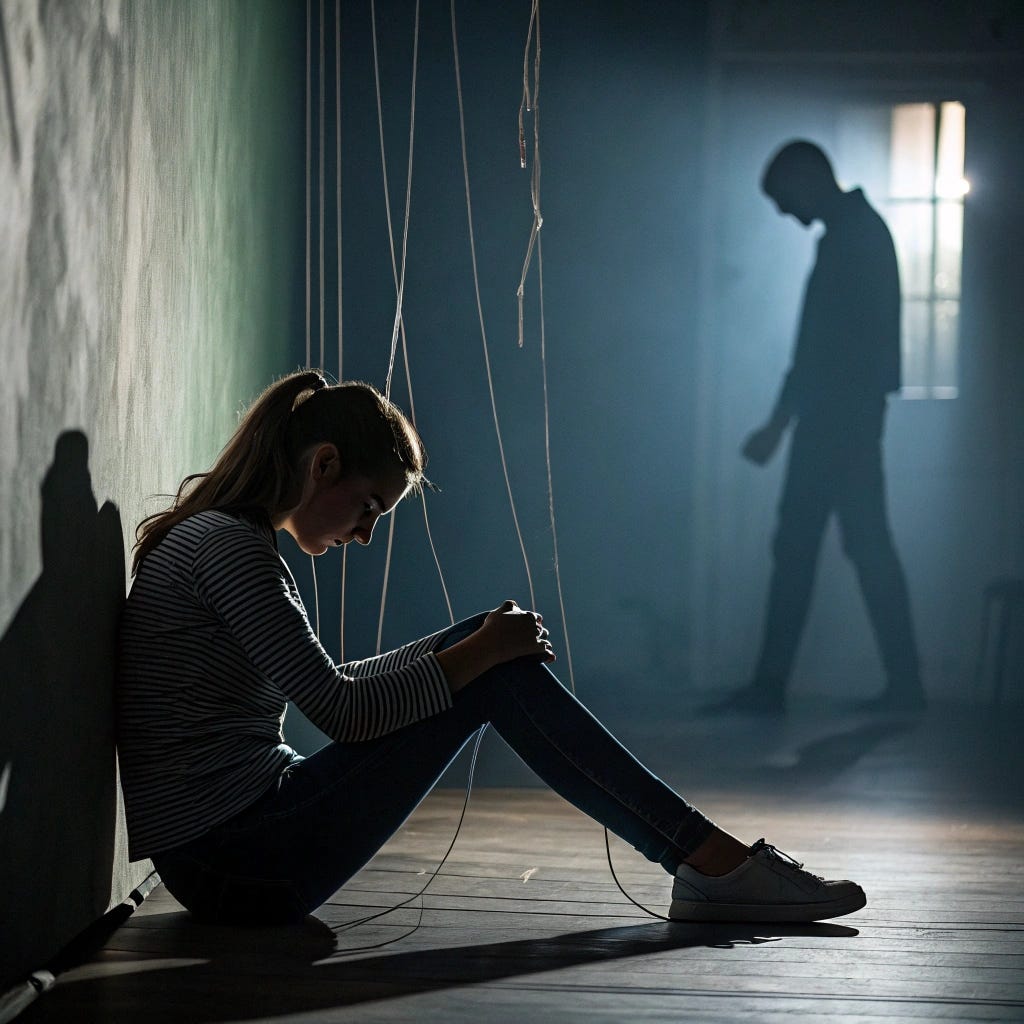Pathological Abuse (PA) isn’t just emotional harm with a darker edge. It’s a calculated assault on the mind and spirit, driven by those with severe personality disorders like Narcissistic Personality Disorder (NPD) or Antisocial Personality Disorder (ASPD).
Where impulsive abusers lash out in fleeting rage, pathological abusers plot. Their goal: to strip away a victim’s autonomy, unravel their reality, and lock in total control.
This destruction thrives in the shadows of collective timidity—a societal flinch that hands abusers the reins. As Beyond Two Sides laid bare, the reflex to chase “neutrality” lets abusers rewrite narratives and dodge accountability.
The lie of “two sides to every story,” dissected in Beyond Two Sides, fuels abusers by sidelining victims’ truths. Here, we dig deeper, exposing how collective timidity empowers not just lone manipulators but entire systems to sustain Pathological Abuse.
Survivors of Pathological Partner Abuse (PPA)—where intimate relationships become battlegrounds for calculated control—face a unique exile. Their pain is often dismissed, not just by society but even within domestic abuse advocacy circles, where their stories don’t fit the usual mold.
Marginalization Within the Abuse Narrative
Too often, PA is mistaken for run-of-the-mill emotional abuse. All abuse wounds, but PA’s deliberate, sinister intent sets it apart. Impulsive abusers stumble through anger or stress. Pathological abusers scheme, using psychological manipulation, cognitive erosion, and relentless attacks on a victim’s sense of self to dominate.
This misconception isolates PPA survivors, even among other abuse survivors. Their experiences—too complex for standard frameworks—are brushed off, leaving them stranded. Key factors include:
Trauma Bonding: Alternating cycles of adoration and cruelty forge a psychological trap, making escape feel impossible.
Specialized Trauma: Attacks tailored to shred identity demand therapies that grasp this layered harm.
Misdiagnosis and Minimization: Stories that don’t fit the mold are mislabeled or ignored.
Mismatched Support Systems: Programs built for conventional abuse often miss PA’s cunning, sometimes enabling the abuser instead.
What Is Collective Timidity?
Collective timidity is the quiet surrender of society and institutions when faced with abuse, especially from the powerful or sly. It stems from:
Fear of Backlash: The threat of retaliation, exclusion, or harm freezes action.
Denial: Facing abuse means admitting complicity or helplessness, a truth many dodge.
Cultural Norms: Valuing harmony over justice silences calls for accountability.
In PA, this timidity shows up as silence or collusion from family, friends, or systems, giving abusers free rein. On a larger scale, it seeps into corporations, politics, and communities, amplifying the damage.
Collective Timidity in Pathological Partner Abuse (PPA)
PPA abusers wield covert weapons—gaslighting, triangulation, financial control, surveillance—to dismantle a victim’s independence. These tactics hit harder when those around the victim shrink into collective timidity.
Examples in PPA:
Families Clinging to Image: Relatives shield the family’s reputation, urging victims to stay quiet to “keep the peace.”
Legal Systems Falling Short: Courts demand hard proof, often dismissing psychological scars as too vague.
Friends Staying Neutral: By refusing to pick a side, friends echo the abuser’s spin, leaving victims alone.
If this article resonates, please watch the music video at the top, subscribe on YouTube, and drop a comment or emoji. Every interaction helps Survivor Music reach more people.
Collective Timidity in Pathological Societal Abuse (PSA)
On a broader stage, collective timidity fuels pathological figures in corporate and political arenas. Leaders and systems twist truths to dodge accountability and crush dissent.
Examples in PSA:
Corporate Cover-Ups: Abusive executives, hailed as stars, are shielded by HR teams chasing profits over people. Whistleblowers get silenced or cast out.
Political Manipulation: Figures with narcissistic or psychopathic traits turn platforms into weapons, deflecting blame and muting critics. Loyalists, gripped by fear or denial, defend them.
Media Collusion: Sensational headlines or shallow probes amplify abusers’ narratives, letting harm fester.
The toll is heavy: corruption settles in, victims vanish into silence, and toxic power endures.
The Ripple Effect of Collective Timidity
Collective timidity doesn’t just shield abusers; it tilts society toward facades over facts, a thread woven through Beyond Two Sides. This fear of raw truths creates a breeding ground for unchecked abuse, perpetuating cycles of harm.
By exposing PA’s tactics and the complicity of collective timidity, we shine a light on how silence fuels these dynamics. Revisiting the pull of “neutrality,” this piece pushes readers to challenge those patterns and their cultural weight.
Confronting the Hidden Epidemic
Pathological Abuse grows where collective timidity keeps it hidden. Naming its calculated, devastating moves is the first strike against the structures that protect abusers and isolate survivors.
From bedrooms to boardrooms to political stages, silence carries a steep price—not just for survivors, but for society’s core.
Creator of Survivor Music | Cindy Ann Pedersen
Pathological Abuse Specialist | Advocate | Award-Winning Songwriter
BlueSky: Social Media
YouTube Channel: Music Videos, SongPods & Podcast
We Resist Radio Collective: Featured Artist & Podcast
cindyannpedersen.com Website
Streaming: Available on most platforms
🎶 Until now, there’s only been protest music and breakup music.
Now it’s time for: Survivor Music. 🎶





Great article, misses out on the rest of the B cluster, but accurate for the two expressions of psychopathy you cover. (NPD and ASPD.)